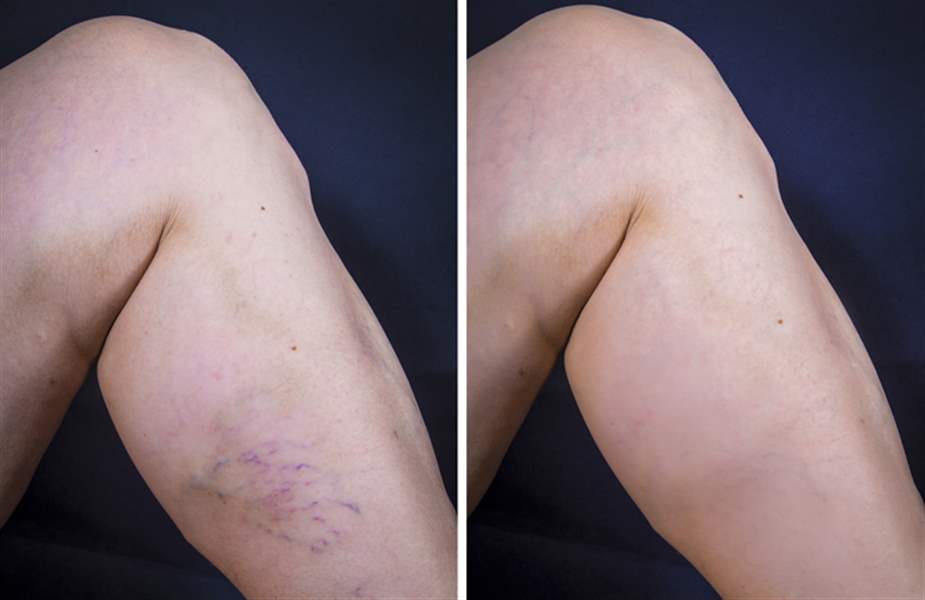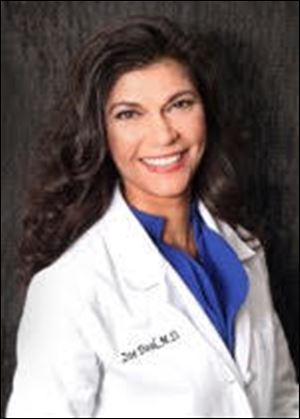
Is it time to get your legs serviced?
2/17/2017
Varicose veins, before and after treatment.
By Zoe Deol, MD, FACS
As we age, we start to get aches and pains in places we never knew existed. We become acutely aware of our backs … our necks… our legs. At the end of a long work day, we hear echoes of our parents complaining, “My back is killing me!” or “I have to put my legs up and rest for a minute!”
It only gets worse when we realize those words came from our own mouths, and not the mouths of our parents. At what point did we transition from the ball of energy that could work a 12-hour day, get groceries, chauffer kids to sporting events, and squeeze in a 60-minute workout without limping home?
We go to the doctor once a year, get our blood drawn, and have our blood pressure checked. We get the routine mammograms and colonoscopies. And just like a car that we have had faithfully serviced, we begin to accept some “lumps and bumps” as routine wear-and-tear, expected of a car your age. However, some of those lumps and bumps, or aches and pains, may be a treatable part of the aging process. Varicose veins are one such example.

Dr. Zoe Deol, MD, FACS
Venous disease is primarily hereditary. Although signs and symptoms of the disease, such as varicose veins or leg swelling, may appear in younger age groups, the incidence of the disease begins to skyrocket after the age of 50. By age 70, most women will have some form of venous disorder.
Several factors lead to the increasing incidence of venous disease associated with age: weakening of the calf muscle, progressive inflammatory changes in the body, and loss of vein wall elasticity. So what can you do to help yourself if you have venous disease? First, strengthen your calf muscles.
The calf muscle is the “heart of the leg.” The heart pumps the blood through the arteries out to your organs and extremities. The calf muscle pumps the blood back up your legs to your heart. Weak calf muscles, or immobility causes the veins to dilate and malfunction. So, join your local YMCA and enroll in their “Silver Sneakers” program. Perform CPR on your calf muscle by doing some toe raises.
As for the inflammatory changes, adopting an anti-inflammatory diet will help. Refined carbohydrates and sugar are pro-inflammatory. Eliminate excess sugar from your diet, and add some powerful anti-oxidants (colorful fruits and vegetables).
Then there is the loss of elasticity. Unfortunately, loss of elasticity is an unavoidable consequence of aging. As we get older, everything begins to sag … including the valves in our veins. The best you can do for this is to adopt a healthy, anti-inflammatory diet. The Mediterranean diet is full of healthy, delicious, anti-inflammatory foods. Try going to a Middle-Eastern restaurant for take-out. Instead of a burger, grab some pita with hummus or tabbouleh.
Finally, remember to take your car in for service. When your legs just can’t get your motor running, get your veins screened, and see if treating them will get you back on the road to a healthier lifestyle.
Dr. Deol is an Ohio native having grown up in Dayton. She attended medical school at Michigan State University’s College of Human Medicine; and she now serves as an assistant clinical professor in their department of surgery. She has been in surgical practice in Metro Detroit for 15 years; and has dedicated her practiced exclusively to endovenous surgery over the past four years. She recently opened an office for Center for Vein Restoration in Oregon, Ohio; and looks forward to caring for the state in which she grew up. She is focused on academic excellence in healthcare; and treats her patients with the care and love she would give her own family.